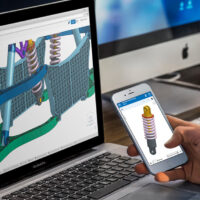Parasolid-based Mechanical CAD, for free. You read that right. Unfettered use of the entire Onshape system for up to 5GB and five private documents at a time is completely free, and a mere $1200/yr for unlimited documents. That’s right folks, the much ballyhooed Onshape just stepped into the ring swinging, and they are poised to cause a shake-up the likes of which haven’t been seen since Gangsta’s Paradise was a number one hit.
Disclaimer:
I’ve worked as a consultant for Onshape a few times. Given that the views expressed here are consistent with articles I wrote before I knew about Onshape, however, Josh and I thought it was fair to publish.
Onshape’s beginnings
Since stepping down as co-founder and CEO of SolidWorks in 2011, the venerable Jon Hirschtick (aka The J-Hirsch) has been oddly quiet. We always envisioned him living in a smoke-filled yurt two hundred miles outside Ulaanbataar milking goats and living off the land. We were way off. As it turns out, he’d been amassing an Dream Team of MCAD and cloud tech elite under the intriguingly nondescript “Belmont Technologies” moniker. Fast forward a couple of years and Belmont becomes Onshape, suddenly revealing that they’ve built a team of over forty engineers, an army of interns, and six of the eight top leadership slots filled with SolidWorks top brass from years gone by.
Their project: a collaborative, 100% browser-based, parametric MCAD system, built from the ground up to run on any platform or device. No installs, service packs or registration codes.
It’s hard to overstate what a monumental accomplishment this is. Parasolid was architected for workstation computing, not distributed cloud computing, so the mere act of adapting the kernel for efficient use across a server rack is an eye opener in itself. Add to that the fact that they’ve built a surprisingly responsive MCAD UI around it that’s cross-browser and mobile compatible from day one, and what they’ve achieved in such a comparatively short time is truly humbling. (Cue the pitter-patter of a thousand face-palms echoing across a Boston suburb.)
Cool technology, no doubt, but the real kicker? Brass tacks.
Onshape pricing
First of all, you can use every feature Onshape offers for free. Full Parasolid based parametric mechanical CAD. Unhindered import/export. Unlimited team size and unlimited sharing. Version control, branching, merging, 5GB of storage. Zero Dollars. Zilch. Free as in Beer.
Students and classrooms? Zero dollars, zero installation required, zero IT overhead. No license servers, no node locks, no dongle-berries. Works on any machine in any lab or classroom on any platform in any building on any campus. Oh, and it works on your iPhone, too.
Then, for $1200/yr, professional engineering teams can frolic unfettered in the flower-laden fields of Onshape. We’ve been assured by persons in the know that the $1200/yr price will continue be all-inclusive even as new functionality is added. That’s it.
Compare that with the new SOLIDWORKS 3DEXPERIENCE applications around $2800/yr per product, not to mention extra charges for showing your work to a client or colleague, and (a) we get kinda excited in ways we don’t discuss in public, and (b) we’re likely to receive some concerned emails with thick accents in the next few hours. (Duck and cover.)
Apples and Oranges
Granted, Onshape is a brand spankin’ new product still wet behind the ears, and that comes with limitations. Its feature offering is impressive for a first-gen MCAD platform, and it’s growing at a break-neck pace. That said, even casual CAD pushers will find its modeling feature set quite limiting at present. Give it a test drive, and you’ll find that it’s, well, very much a work-in-progress.
Given that Onshape is still in its infancy, it’s not really fair to compare its pricing with more established engineering platforms. Or is it?
Go back to the classroom example: why bother with the IT overhead of a traditional CAD system–not to mention spending a few hundred bucks per seat–when I could just point my students to onshape.com and get going on day one? What about all those folks buying ShopBots, OtherMills, Carveys, Form 1’s, and those love-to-hate Makerbots? Every stinkin’ one of ’em just signed up for Onshape. What about the rapidly increasing number of engineering contractors, freelancers, and boutique design shops all over the world, Dads with too many power tools, kids who take things apart, or anyone currently using Sketchup?
Why wouldn’t you sign up for OnShape, even if only to use it occasionally?
Apples and Apples
“Now wait” you’re thinking (I’m talkin’ to you, @ScottMoyse), “what about Fusion 360?” Well said, Scott. Just where we were headed.
Fusion 360 has a free version too. It’s also got a $300/yr product that is more capable than Onshape at this stage, and a $1200/yr product (same exact price as Onshape… hmmm….) that is far, far more capable. One can only assume that Onshape’s pricing is a stake in the ground rather than a realistic valuation of its current capabilities. We won’t do a feature comparison chart just yet, but suffice it to say that Onshape wouldn’t stack up well against Fusion if we were to compare them today.
One might point out that F360 requires an installed app on your OS of choice, while Onshape requires only a browser. Most people don’t remember that Fusion 360 was originally, like Onshape, an entirely browser-based product. Users pushed back due largely to performance and graphics limitations inherent to WebGL, not to mention the near-constant stream of IP data required to keep an in-browser tool running means that any little blip in connectivity causes serious problems. The fact that F360 is an installed product today is not because Autodesk couldn’t build a browser version, but because users demanded a level of performance that the browser simply couldn’t provide.
So why, one wonders, is Onshape a bigger deal than F360? It’s not, really. Fusion 360 was exciting when it came out, and we’ve been watching it eagerly over the last couple of years. The difference is that now there are two players in the cloud CAD space. The addition of Onshape means that cloud CAD is no longer just a little experiment in Autodesk Labs. Fusion 360 was a huge step forward, but one little product does not an industry revolution make. With Onshape in the ring, things get interesting.
Fight The Power
I can’t stress enough what a big deal this is. Forget about features, workflow, and the normal bla bla bla about cloud, collaboration, multi-CAD compatibility, etc. It’s all about The Benjamins. Even if Onshape itself turns out to be a dud (it won’t), mark my words: the game has changed.
It’s no longer enough for The MCAD Syndicates to sell CAD by the “seat” with complex bundling restrictions, bizarre and arbitrary licensing schemes, and pricing that was dreamed up in a backroom sales negotiation at Boeing or GM. Even if Onshape is only moderately successful as a product in itself, it will force the industry to re-examine regressive revenue models in favor of simpler, more straightforward, customer-oriented value propositions.
Adobe was first with Creative Cloud, offering their entire product line for a single, simple price. It’s easy, affordable, and a no-brainer for customers like me. Autodesk was second with Fusion 360, offering an impressively feature rich CAD platform with a dead-simple two-tier pricing model, another no-brainer for small and medium businesses who need Mechanical CAD without the overhead of a full PLM system. Now it’s Onshape. It will take a good long while for bigger players to change course, but rest assured, they will.
And, I need to re-emphasize a crucial point: this isn’t about merely cheaper pricing for its own sake. My point is not egalitarian so much as good practical business sense: with the explosion of interest in extruder nozzles and mill bits in the public consciousness, the potential market for 3D creation tools just went bananas, b-a-n-a-n-a-s.
Is this a race to the bottom of the Feature Tree? Is advanced MCAD about to become a cheap commodity in a price-driven push market? Not a chance. There will always be a need for costly high-end systems that are only supported by an elite niche, and therefore demand a premium. But as the need for competent 3D design tools becomes mainstream, those tools will get cheaper. High end simulation and manufacturing tools will probably always the expensive prerogative of serious engineering businesses customers, but geometry creation and assembly design tools will not.
Sometimes industries have to be “dragged kicking and screaming to the money tree, and have it shaken for them.” Onshape is doing just that.
A nuanced debate
I’ve always said that if a CAD tool makes me twice as productive in a business context, that tool is worth my salary. If I can get $160k worth of work out of a $80k engineer by using XYZ CAD system, then I should be willing to pay XYZ CAD Systems Inc as much as $80k for it. Anything less than that, and they’re making me money. If they charge $40k, suddenly they just made me $40k. If they charge $5k for it, buying XYZ CAD just made me $75k. Hell yes.
That’s why it’s so important to understand that what I’m saying here is not about mere “affordability” or “democratization” or any such Utopian fluff. Professional MCAD systems are valuable. Good tools not only pay for themselves, they make me money. And I like making money. Dassault, PTC, or Siemens can promise to double my output, I’m willing to pay handsomely for that. But the market for 3D tools like these has fundamentally changed, and that’s the real point here. 3D design tools aren’t just for professional engineering firms anymore, so the entire value proposition is shifting.
If I told you I could sell a million seats of XYZ CAD over the next year, would you be willing to sell it for $100? Of course you would. And that’s what’s happening. It’s an exciting time to be in this industry.
Beware, Ye Cloud Deniers
On a slight tangent, I can’t end this article without a word to those of you–you know who you are–still holding steadfast to your little LAN-locked utopias, pining for the days when Men were Men and Computers were Big Beige Boxes.
CAD in the Cloud has arrived. It’s real, it’s here, and everybody’s doing it. Haters hate and nay-sayers say nay, but whether you like it or not, over the next decade desktop CAD users will become increasingly lonely, frustrated, passed over for slices of cake at office birthday parties, and bizarrely obsessed with Swingline staplers. As with any industry transition, there are problems-a-plenty with the Cloudy Thinking that’s pervaded the MCAD world in recent years, but the trajectory is clear: desktop CAD is sooooo Y2K. (Oh Mighty Interwebs, flex thy bulging quadriceps!)
What about the evil PLM Dragons hoarding your Precious Data at the heart of the mountain, sending you daily email reminders that “All Your Data Are Belong To Us?” It’s a big topic. Lets have that conversation over a glass of pure grain alcohol (“Our precious bodily fluids!”) and binge on moon landing conspiracy documentaries afterwards.
Oh, and what happens to your Cloud CAD when the internet is down? Hold that thought, I need to go refuel my backyard generator and restock the shelves in the bomb shelter downstairs.
It doesn’t matter whether you stand up, wave your fists around and scream about Cloud this or Rentalware that. If you want to live off MRE’s while working in a locked basement with nothing more than a telegraph, a stack of acid-free paper napkins, and your favorite archival India Ink rollerball, that won’t change the fact that the industry is changing. It will happen whether you’re along for the ride or not. And that’s a good thing.
What do you think?
I’ve never been accused of having too few opinions, or for holding them too loosely. That said, I don’t hazard public prognostications lightly. It’s true that I’ve done some consulting for OnShape, just as I have for lots of other companies over the last six or seven years. I’m a consultant. It’s what I do.
But what I’ve written here isn’t really about OnShape per se. This article, along with the last few I’ve written, is really about a changing industry. As loth as I am to give credence to grandiose claims about a so-called 3D printing “revolution,” (exasperated eye roll) one has to admit that the public exposure the 3D CAD industry has seen as a result has already been a force for change, and one that my daughter will benefit from.
By the time my daughter is in middle school, she’ll be using tools like OnShape to design things for STEM projects as a matter of course. And that, friends, really gets me excited.





![6 Types of Civil Engineering Drawings [Detailed Guide]](https://www.solidsmack.com/wp-content/uploads/2023/12/Civil-Engineering-Drawings-270x180.jpeg)

